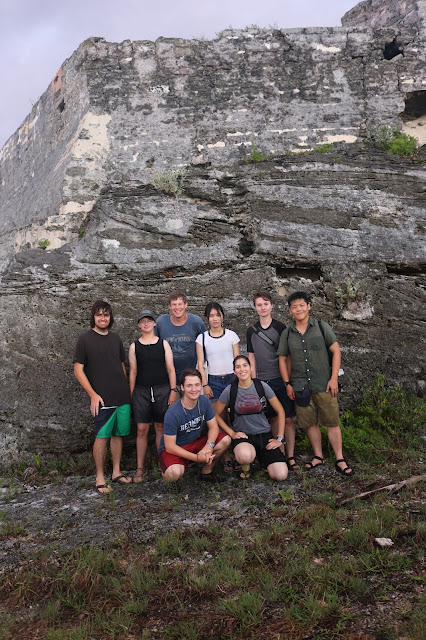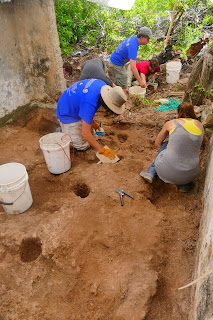 |
| Group Portrait at Devonshire Redoubt, Castle Island |

We are now hitting the mid-season mark of this year's field school and have been frantically busy this past week, both moving a lot of dirt and immersing ourselves in Bermuda's past and present. Last week, a general election shifted control of Bermuda's government from one party to another in an entirely civil manner. The next day it was business as usual at the Bermuda Archives, where the students got to look at manuscript records dating to 1616, 17th-century maps showing houses on Smiths Island, and the 1706 inventory of Captain Boaz Sharp, which documents Oven Site. And Friday, we got a spur-of-the-moment tour of the
Spirit of Bermuda as she prepared for a voyage to Halifax - and then got to see her sail off Saturday morning!



Captain Phoopa Anderson graciously took us out to Castle Harbour as a birthday treat for me on his new glass-bottom boat
Skinny Dipper. We got to see some of the oldest standing fortifications in English America - King's Castle and Devonshire Redoubt, both dating to 1620 and the subject of several William and Mary field schools in the 1990s led by Drs. Norman Barka and Edward Harris. A heavy downpour scuppered plans for a barbecue on a nearby beach, but serendipitously this landed us in King's Square in the middle of the town's Cup Match celebration.
 |
| A future archaeologist? |
As for the digging, much of this week was spent preparing for our public presentation in St. George's World Heritage Center on Thursday and public tours of our sites this past Saturday, arranged by the Bermuda National Trust (thanks Bill and Peter!!!). The talk was well attended and gave me an excuse to wear my pink Bermuda shorts, and the tour was especially popular, with more than forty people venturing across the harbour to visit us despite the heat.
 |
| Leigh interpreting Smallpox Bay Site |
 |
| A full house at Oven Site |


Preparing for the tour involved several days of intensive work, particularly in removing all the backfill from previous seasons at Smallpox Bay. It was very rewarding, though, to see the full array of postholes see the light of day once again, and to plan where to put units in next week to follow out the three different lines of posts we can now discern.

At Oven Site, we had a bit of a disappointment with the cistern. Given the scattered presence of 17th century ceramics in the cistern's fill, we had high hopes of finding a greater concentration on the tarris tank's floor, which logically would have served as a ready-made trash pit upon the site's abandonment.

The tank's lining did prove to be tarris - a waterproof cement made by incorporating brick dust - but the very bottom-most layer was composed of a set cement-like slurry of reconstituted Bermuda stone, which was very hard to remove and had to be chiseled out. In the midst of this, we found a large heat-altered piece of a whale vertebra, but also two sherds of early 19th-century white ware incontrovertibly in situ, which dates the filling of the cistern to that period (the cistern/tank itself may be much older, but its abandonment and filling came then). Upon revealing the original bottom, we could clearly see a set of cracks that rendered it useless and leaky, and speculate that when it no longer served its original water catchment purpose, it served a last function as a mortar mixing pit.
 |
| Profile of the Cistern Fill. Note the large post hole to the left (north) and the smooth plaster floor |
 |
| The exploratory trench laid out |

But work continues to both connect this area with the previously excavated portions of Oven Site and also to expose an exploratory trench to the north of the cistern in an effort to find the larger main house we hypothesize should be nearby. Thankfully, our public talk and tour generated considerable interest among volunteers, and we should have a fair bit of Bermudian help in the two weeks we still have left to dig.
 |
| Sean is tired of using just a trowel |




 Captain Phoopa Anderson graciously took us out to Castle Harbour as a birthday treat for me on his new glass-bottom boat Skinny Dipper. We got to see some of the oldest standing fortifications in English America - King's Castle and Devonshire Redoubt, both dating to 1620 and the subject of several William and Mary field schools in the 1990s led by Drs. Norman Barka and Edward Harris. A heavy downpour scuppered plans for a barbecue on a nearby beach, but serendipitously this landed us in King's Square in the middle of the town's Cup Match celebration.
Captain Phoopa Anderson graciously took us out to Castle Harbour as a birthday treat for me on his new glass-bottom boat Skinny Dipper. We got to see some of the oldest standing fortifications in English America - King's Castle and Devonshire Redoubt, both dating to 1620 and the subject of several William and Mary field schools in the 1990s led by Drs. Norman Barka and Edward Harris. A heavy downpour scuppered plans for a barbecue on a nearby beach, but serendipitously this landed us in King's Square in the middle of the town's Cup Match celebration.


 Preparing for the tour involved several days of intensive work, particularly in removing all the backfill from previous seasons at Smallpox Bay. It was very rewarding, though, to see the full array of postholes see the light of day once again, and to plan where to put units in next week to follow out the three different lines of posts we can now discern.
Preparing for the tour involved several days of intensive work, particularly in removing all the backfill from previous seasons at Smallpox Bay. It was very rewarding, though, to see the full array of postholes see the light of day once again, and to plan where to put units in next week to follow out the three different lines of posts we can now discern. 



 But work continues to both connect this area with the previously excavated portions of Oven Site and also to expose an exploratory trench to the north of the cistern in an effort to find the larger main house we hypothesize should be nearby. Thankfully, our public talk and tour generated considerable interest among volunteers, and we should have a fair bit of Bermudian help in the two weeks we still have left to dig.
But work continues to both connect this area with the previously excavated portions of Oven Site and also to expose an exploratory trench to the north of the cistern in an effort to find the larger main house we hypothesize should be nearby. Thankfully, our public talk and tour generated considerable interest among volunteers, and we should have a fair bit of Bermudian help in the two weeks we still have left to dig.






.jpg)
Comments